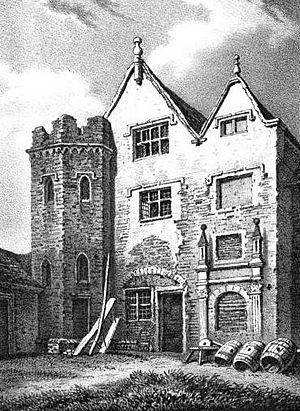Francis Gawdy facts for kids
Sir Francis Gawdy was an important English judge who lived a long time ago. He was born in England and passed away on December 15, 1605. He held very high positions in the legal system, like being a judge in the King's Bench and later the Chief Justice of the Common Pleas. His family homes and lands were located in Norfolk, a county in England.
Contents
Sir Francis Gawdy's Life and Work
Early Life and Name Change
Francis Gawdy was the third son in his family. Interestingly, he was given the name Thomas when he was born, just like his two older half-brothers. To avoid confusion, he later changed his first name to Francis. This happened when he was confirmed, which is a religious ceremony. This event actually set a new rule that a name given at birth could be changed later.
Becoming a Lawyer
Francis Gawdy likely studied at Trinity Hall, Cambridge, a famous university. He then trained to become a lawyer at a place called Inner Temple, which is one of the oldest law schools in London. He became a full lawyer in 1549. As he got more experienced, he took on important roles at Inner Temple, like being a senior lawyer (called a 'bencher') and managing the school's money (as 'treasurer'). He also taught law to younger students.
While he was elected to Parliament once, representing a place called Morpeth, he mostly focused on his legal work. He became a 'Serjeant-at-law' in 1577. This was a special rank for top lawyers. Later, he became the 'Queen's Serjeant' in 1582, meaning he was one of the Queen's main legal advisors. In this role, he helped with the legal case against Mary, Queen of Scots.
Marriage and Family Homes
In 1563, Francis Gawdy married Elizabeth Coningsby. Through his marriage, he gained ownership of several important homes and lands in Norfolk. These included Fincham Hall and Wallington Hall. Wallington Hall had belonged to Elizabeth's father, Christopher Coningsby. Christopher Coningsby was also a legal official, serving as a 'Recorder' in King's Lynn.
A Judge's Later Years
In 1588, Francis Gawdy became a judge in the King's Bench, taking over from his older brother. He was one of four judges chosen to handle important legal cases when the Lord Chancellor, Sir Christopher Hatton, passed away in 1591.
Gawdy was involved in many major trials during this time, including the famous trial of Sir Walter Raleigh in 1603. He was knighted in the same year, which meant he was given the title 'Sir.' He had hoped to become the Lord Chief Baron of the Exchequer, another very high legal position. However, King James I told him he was being saved for an even more important role later on.
Raising His Granddaughter
Francis Gawdy had one daughter named Elizabeth. She married Sir William Hatton in 1589. Sadly, Elizabeth passed away during her father's lifetime. She left behind an only daughter, Frances, who was born in 1590. Francis Gawdy himself raised his granddaughter Frances.
In February 1605, Frances married Robert Rich. This marriage happened without her grandfather's approval. After this, Francis Gawdy stopped communicating with his granddaughter.
In August 1605, Francis Gawdy was appointed Chief Justice of the Common Pleas. This was a very senior position. However, he did not get to enjoy it for long. He passed away suddenly on December 15, 1605.
Death and Burial
After his death, Francis Gawdy's body was brought from London to Wallington. It is said that it was difficult to find a place to bury him locally. Eventually, he was buried without a formal ceremony at North Runcton church. The church records show he was buried there on February 27.
In the 1800s, it was noted that Wallington church was in ruins, but Wallington Hall itself was well-maintained. Wallington Hall is still standing today. It is located near King's Lynn and covers a large area of nearly 600 acres.
Images for kids



